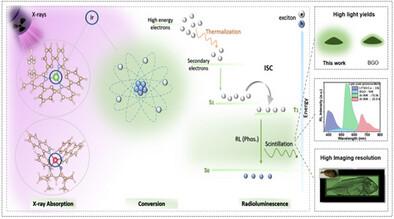Nearly Unity Intersystem Crossing in Organometallic Emitters Enabling High-Performance X-Ray Scintillators
IF 19
1区 材料科学
Q1 CHEMISTRY, MULTIDISCIPLINARY
引用次数: 0
Abstract
Advanced X-ray imaging scintillators hold great potential for medical diagnostics, security screening, and aerospace applications. However, organic materials encounter significant challenges in achieving high X-ray absorption and efficient exciton utilization due to their low atomic number and weak intersystem crossing (ISC), resulting in limited triplet emission when exposed to light excitation. Here, organometallic materials incorporating heavy-atom metal centers and organic linkers are developed as highly efficient X-ray imaging scintillators, exhibiting near-unity ISC and remarkable phosphorescence efficiency. Their optimized triplet-state properties and enhanced exciton utilization enable superior performance in X-ray imaging, offering improved sensitivity and spatial resolution. Notably, these materials achieve an ultralow X-ray detection limit of 84 nGy s−1, an impressive imaging resolution of 26.9 lp mm−1, and an outstanding light yield of 70.5 k photons MeV−1, substantially outperforming conventional organic and inorganic scintillators available in the X-ray imaging market. Moreover, these organometallic scintillators demonstrate nearly a threefold improvement in X-ray sensitivity at low temperatures, highlighting their significant potential for low-temperature X-ray imaging.

实现高性能x射线闪烁体的有机金属发射体中几乎统一的系统间交叉
先进的x射线成像闪烁体在医疗诊断、安全检查和航空航天应用方面具有巨大的潜力。然而,有机材料在实现高x射线吸收和有效的激子利用方面遇到了重大挑战,因为它们的低原子序数和弱系统间交叉(ISC)导致暴露于光激发下的三态发射有限。本文研究了含重原子金属中心和有机连接体的有机金属材料作为高效的x射线成像闪烁体,具有接近统一的ISC和显著的磷光效率。他们优化的三重态特性和增强的激子利用率使x射线成像性能优越,提供了更高的灵敏度和空间分辨率。值得注意的是,这些材料实现了84 nGy s−1的超低x射线检测极限,令人印象深刻的成像分辨率为26.9 lp mm−1,以及70.5 k光子MeV−1的出色产光率,大大优于x射线成像市场上现有的传统有机和无机闪烁体。此外,这些有机金属闪烁体在低温下的x射线灵敏度提高了近三倍,突出了它们在低温x射线成像方面的巨大潜力。
本文章由计算机程序翻译,如有差异,请以英文原文为准。
求助全文
约1分钟内获得全文
求助全文
来源期刊

Advanced Functional Materials
工程技术-材料科学:综合
CiteScore
29.50
自引率
4.20%
发文量
2086
审稿时长
2.1 months
期刊介绍:
Firmly established as a top-tier materials science journal, Advanced Functional Materials reports breakthrough research in all aspects of materials science, including nanotechnology, chemistry, physics, and biology every week.
Advanced Functional Materials is known for its rapid and fair peer review, quality content, and high impact, making it the first choice of the international materials science community.
 求助内容:
求助内容: 应助结果提醒方式:
应助结果提醒方式:


